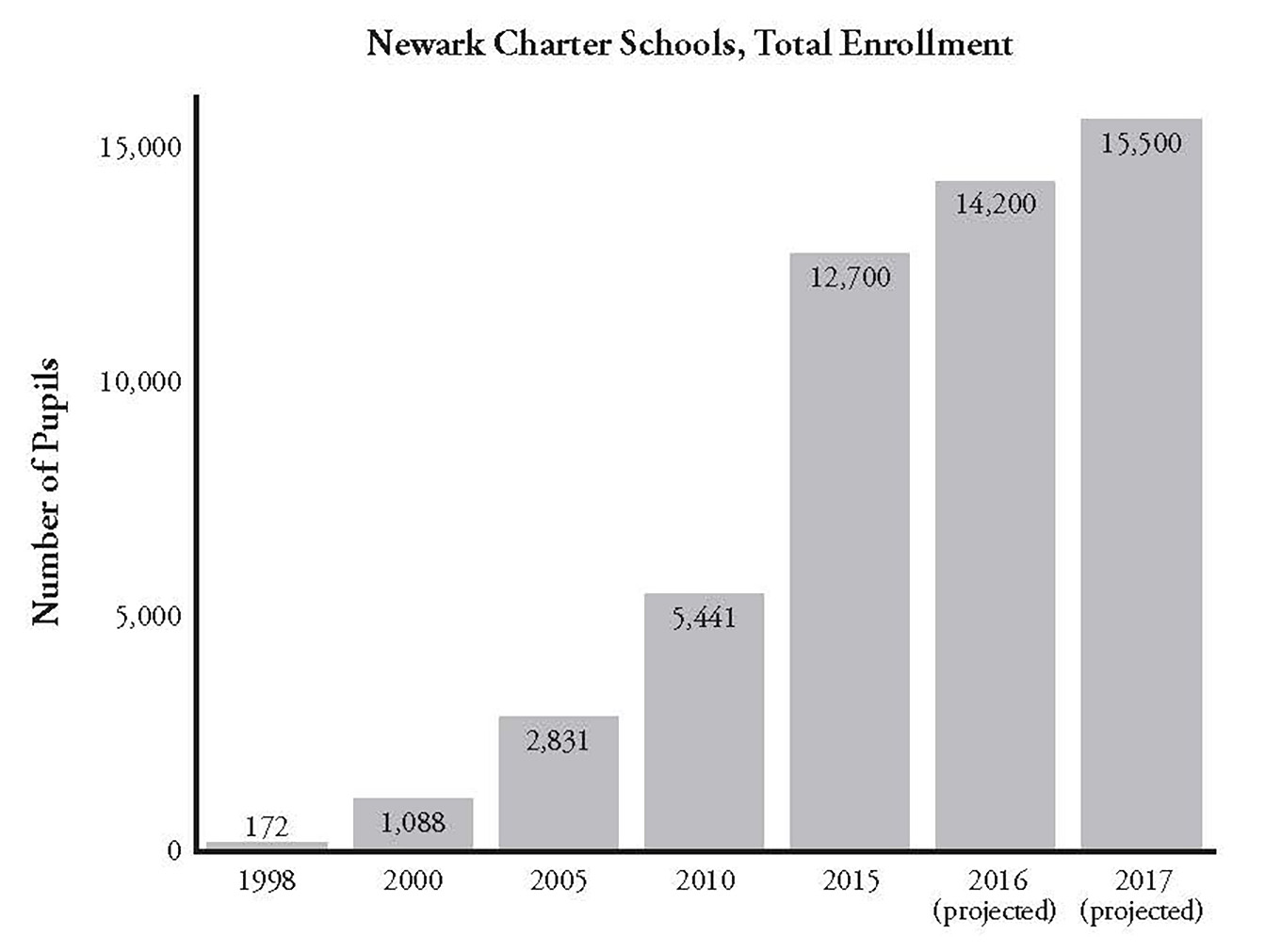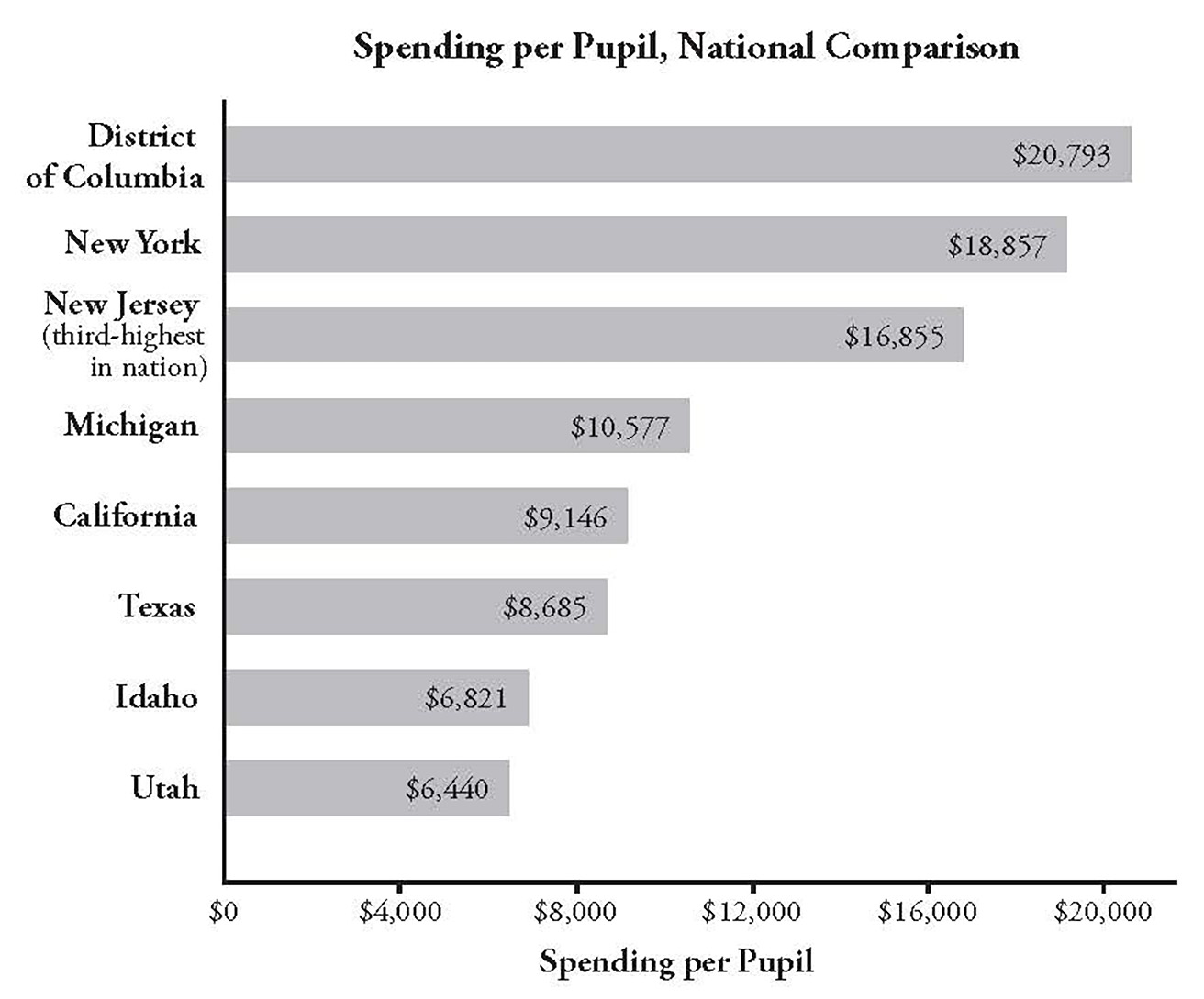The Prize (32 page)
Authors: Dale Russakoff

TEACH FOR AMERICA:
$1 million to train teachers for positions in Newark district and charter schools
COMMUNITY GRANTS FROM THE FOUNDATION FOR NEWARK'S FUTURE:
Start-up costs for four new district high schools: $2.1 million
My Very Own Library: $3 million literacy initiative, giving books to 12,000 elementary school students to start home libraries and engaging parents to read with them
Newark City of Learning Collaborative: $1.5 million to community initiative to double the number of Newark residents with college degrees in ten years
After-school and extended-day programming: $1.2 million
Early-childhood grants: $1 million
Teacher Innovation Fund: $600,000 in grants of up to $10,000 each to classroom teachers for innovative projects with potential to be replicated
BRICK
and South Ward Children's Alliance: almost $500,000
for home-grown school improvement effort linked with wraparound services for familiesYouth Leadership and Development: almost $1 million on three programs: College Summit, the Future Project, and the Center for Supportive Schools
Support for local education foundations: $650,000 donated to a fund created by local philanthropies to pool and coordinate local support for education
Note:
The total of the philanthropic funds spent or committed as of January 2015 comes to less than $200 million because some funding decisions were still pending and smaller grants are not listed.
Source:
IRS Forms 990 filed by Foundation for Newark's Future (2011, 2012, 2013), FNF website, documents supplied by staff of Newark Public Schools
Appendix II



SPENDING PER PUPIL, 2014â2015
Newark district schools: $19,650 (This amount represents remaining per-pupil sum after payments to charters and pre-K are subtracted; of the $19,650, an average of $9,604 per pupil reaches schools.)
Newark charter schools: $16,400 (There is no available data on average amount reaching charter school classrooms. According to Newark's
KIPP
schools, $12,664 reaches its
SPARK
Academy elementary school.)

NEWARK POVERTY STATISTICS
71% of households headed by a single parent
42% of children live below poverty level (2010)
$27,038 median income for families with children (2010)
NEW JERSEY POVERTY STATISTICS
30% of households headed by a single parent
14% of children live below poverty level (2010)
$83,208 median income for families with children (2010)
Sources:
Newark Public Schools, Newark Board of Education, New Jersey Charter Schools Association, Parthenon Group,
KIPP
schools,
http://nces.ed.gov/pubsearch/pubsinfo.asp?pubid=2014301
.
I researched this book primarily through interviews and firsthand observations. The notes below refer only to information on Newark and education that I researched in books, journals, newspapers, state and school district records, and online.
1. The Pact
[>]
Â
Christie had made urban schools:
David Halbfinger,
“
Christie Aims at Democrats Unhappy with Poor Schools,” June 18, 2009.
http://www.nytimes.com/2009/06/19/nyregion/19choice.html
.
[>]
Â
“We're paying caviar prices”:
John Mooney, “Spotlight Video: Isaac,” February 11, 2011, town hall meeting in Union City, New Jersey. Christie was responding to a mother named Yvonne Moore, who said her son couldn't get services for his disability in Newark schools.
http://www.njspotlight.com/stories/11/0210/2248
.
[>]
Â
Only 12.5 percent:
United States Census Bureau, “State and County Quick Facts” for Newark, New Jersey.
http://quickfacts.census.gov/qfd/states/34/3451000.html
.
[>]
Â
Newark was an extreme example:
Newark Public Schools, “School Snapshot
for Families.” See, for example,
http://www.nps.k12.nj.us/wp-content/up loads/mdocs/FamilySnapshot_K8_ThirteenthAvenue.pdf
.
[>]
Â
Forty-four percent of city children:
Advocates for Children of New Jersey, “2012â2013 Newark Kids Count: A City Profile of Child Well-Being,” pp. 26, 29, 40.
http://acnj.org/downloads/2013_02_01_NewarkReport.pdf
.
[>]
Â
Henry Ford created the Ford English School:
“Ford Motor Company Sociological Department and English School.”
www.thehenryford.org/research/englishSchool.aspx
.
[>]
Â
“If an unfriendly foreign power”: A Nation at Risk: The Imperative for Educational Reform
is the full title of the 1983 report of President Ronald Reagan's National Commission on Excellence.
[>]
Â
Beginning in 2000:
Foundation Stats: The Foundation Center's Statistical Information Service, “Top 50 Foundation Awarding Grants for Elementary and Secondary Education, Circa 1998, 2000, and 2006.”
foundationcenter.org/findfunders/statistics
.
[>]
Â
the fastest and most tumultuous turnover:
Robert Curvin, “The Persistent Minority: The Black Political Experience in Newark,” PhD dissertation, Princeton University, 1975, p. 13.
[>]
Â
Newark cleared more slums:
The displacement of Newark residents is discussed in
Report of the National Advisory Commission on Civil Disorders
(Washington, D.C.: U.S. Government Printing Office, 1968), also known as the Kerner Report, p. 142;
Curvin, “The Persistent Minority”; and Mindy Thompson Fullilove, MD,
Root Shock
(New York: Ballantine Books, 2004), pp. 52â70.
[>]
Â
“Good houses make good citizens”:
Brad R. Tuttle,
How Newark Became Newark: The Rise, Fall and Rebirth of an American City
(New Brunswick, NJ: Rivergate Books, 2009), p. 127.
[>]
Â
A state investigation later found:
“Report for Action,” Governor's Select Commission on Civil Disorders, State of New Jersey, February 1968, p. 55.
[>]
Â
“one of the most volatile”:
Quoted in Curvin, “The Persistent Minority,” p. 15.
[>]
Â
“In schools with high Negro enrollments”:
United States Commission on Civil Rights, Hearings Before the United States Commission on Civil Rights, Newark, New Jersey, September 11â12, 1962 (Washington, D.C.: U.S. Government Printing Office, 1963), p. 403.
http://babel.hathitrust.org/cgi/pt?id=mdp.39015012165851;view=1up;seq=425
.
[>]
Â
Former U.S. representative Hugh Addonizio:
Jean Anyon,
Ghetto Schooling: A Political Economy of Urban Educational Reform
(New York: Teachers College Press, 1997), p. 107.
[>]
Â
Newark exploded in six days:
Accounts of the riots were taken from “Report for Action,” pp. 30â38; and Robert Curvin,
Inside Newark
(New Brunswick, NJ: Rutgers University Press, 2014), pp. 100â127.
[>]
Â
Its report stated, of urban renewal:
“Report for Action,” p. 55, 82.
[>]
Â
“I think somewhere along the line”:
Ibid., p. 75.
[>]
Â
In the early 1980s:
Curvin,
Inside Newark
, pp. 280â82.
2. Seduction in Sun Valley
[>]
Â
“Mark is following up”:
The emails sent by Sheryl Sandberg and Bari Mattes were obtained in an open-records lawsuit by the ACLU of New Jersey.
3. The View from Avon Avenue
[>]
Â
Nearly half of the children:
The data is taken from Table 10 and explanatory notes on page 27 of
Barriers to Upward Mobility: A Spatial Analysis of Newark and the Challenges to Human Development
, a report by the Cornwall Center of Rutgers University.
https://www.cornwall.rutgers.edu/sites/default/files/files/Assesments/barriers_to_upward_mobility.pdf
.
[>]
Â
“A generous description”:
“Rescuing Avon Avenue School,”
http://www .thechadschoolfoundation.org/avon-report2011.pdf
.
[>]
Â
“an inability to captivate student interest”:
This assessment comes from Avon Avenue School's April 29, 2010, application for a federal School Improvement Grant, under a section titled “Curriculum and Quality of Instruction,” pp. 8, 9.
[>]
Â
In a series of rulings:
For a history of the
Abbott v. Burke
litigation, see
http://www.edlawcenter.org/cases/abbott-v-burke/abbott-history.html
.
[>]
Â
Research had shown that children:
B. Hart and T. R. Risley,
Meaningful Differences in the Everyday Experiences of Young American Children.
(Baltimore, MD: Brookes Publishing, 1995), p. 132. Follow-up studies have found that these different experiences had lasting impacts on children's performance in later years.
4. Engaging the Community
[>]
Â
“Education reform is not about”:
Michael Lomax
, “Education Reform: What Adrian Fenty and Michelle Rhee Got Wrong,” September 21, 2010.
http://www.theroot.com/articles/politics/2010/09/what_dc_mayor_adrian_fenty_and_schools_chancellor_michelle_rhee_got_wrong_about_school_reform.html
.
[>]
Â
a study revealed that in the 2012â13 school year:
The Southern Education Foundation found that fifty-one percent of students in pre-kindergarten through twelfth grade in the 2012â13 school year were eligible for the federal program that provides free and reduced-price lunches.
http://www.southerneducation.org/getattachment/4ac62e27-5260-47a5-9d02-14896ec3a531/A-New-Majority-2015-Update-Low-Income-Students-Now.aspx
.